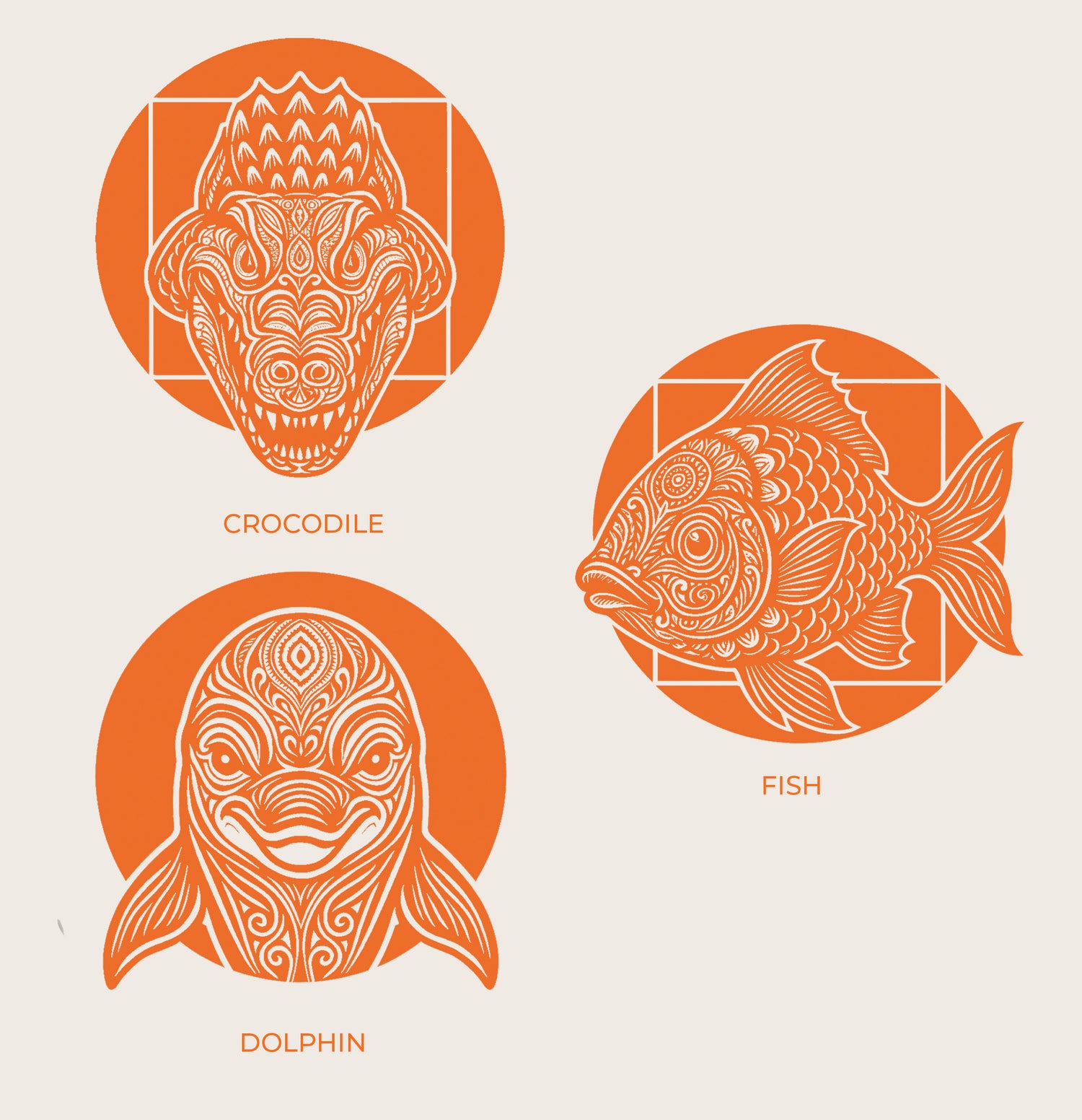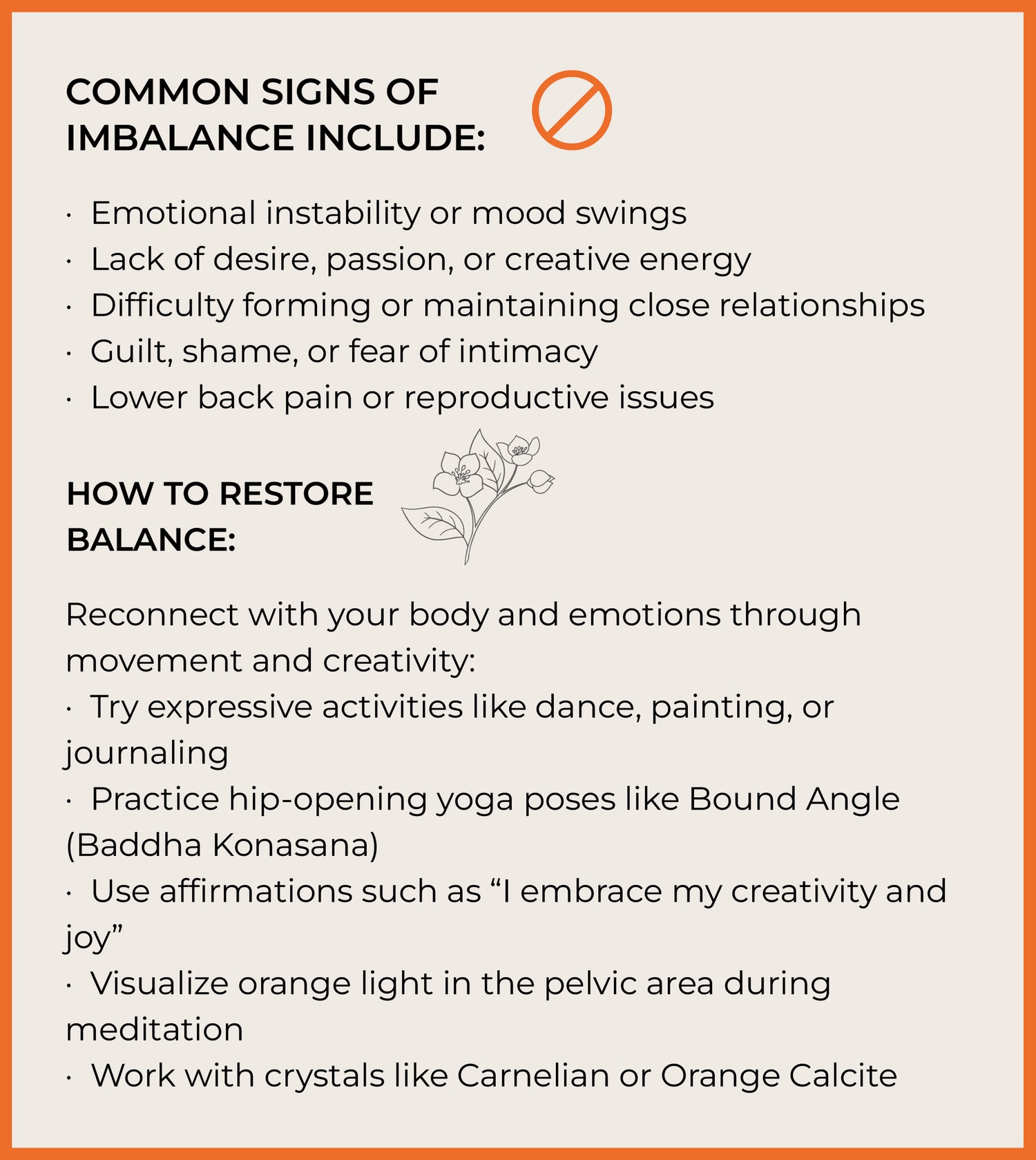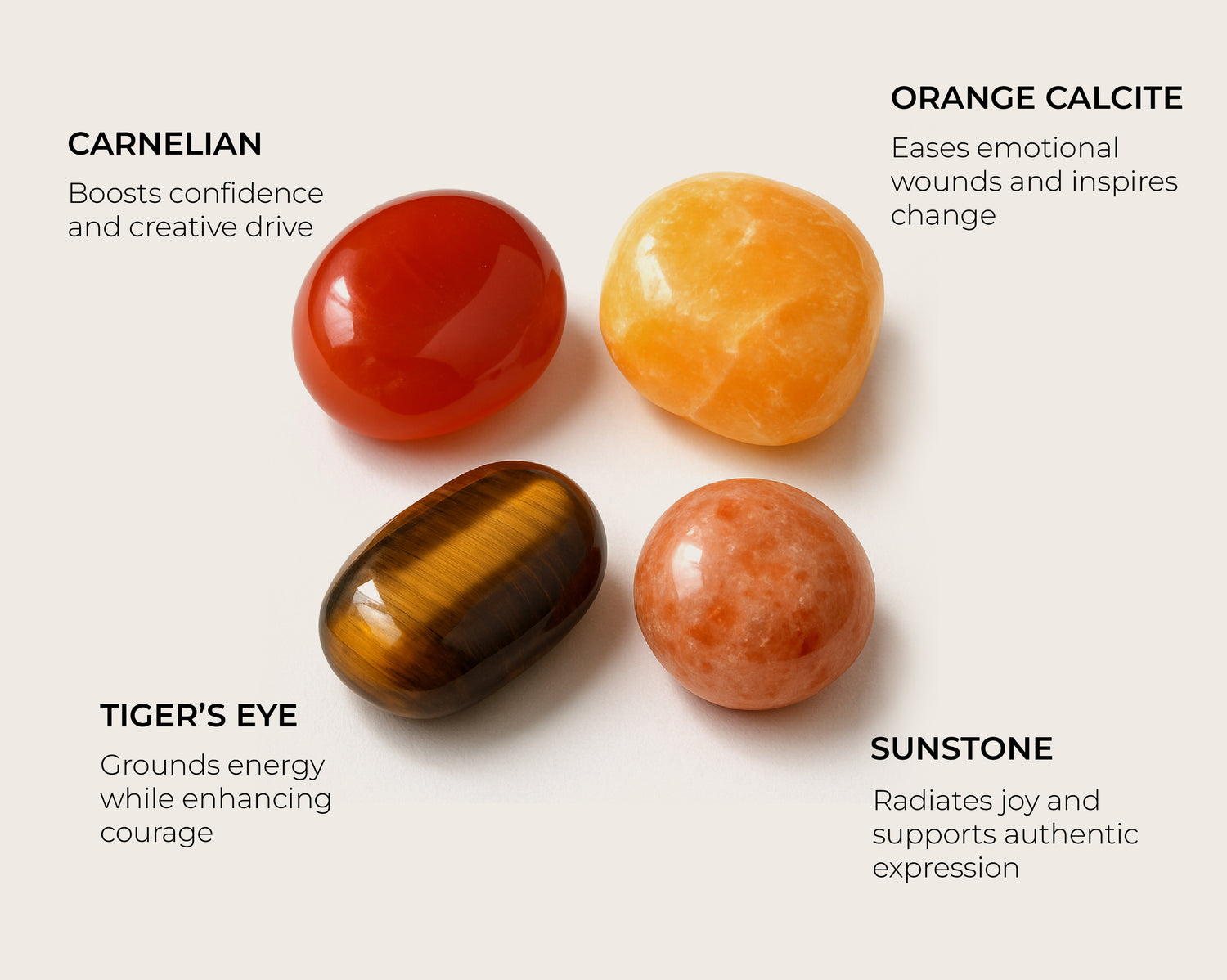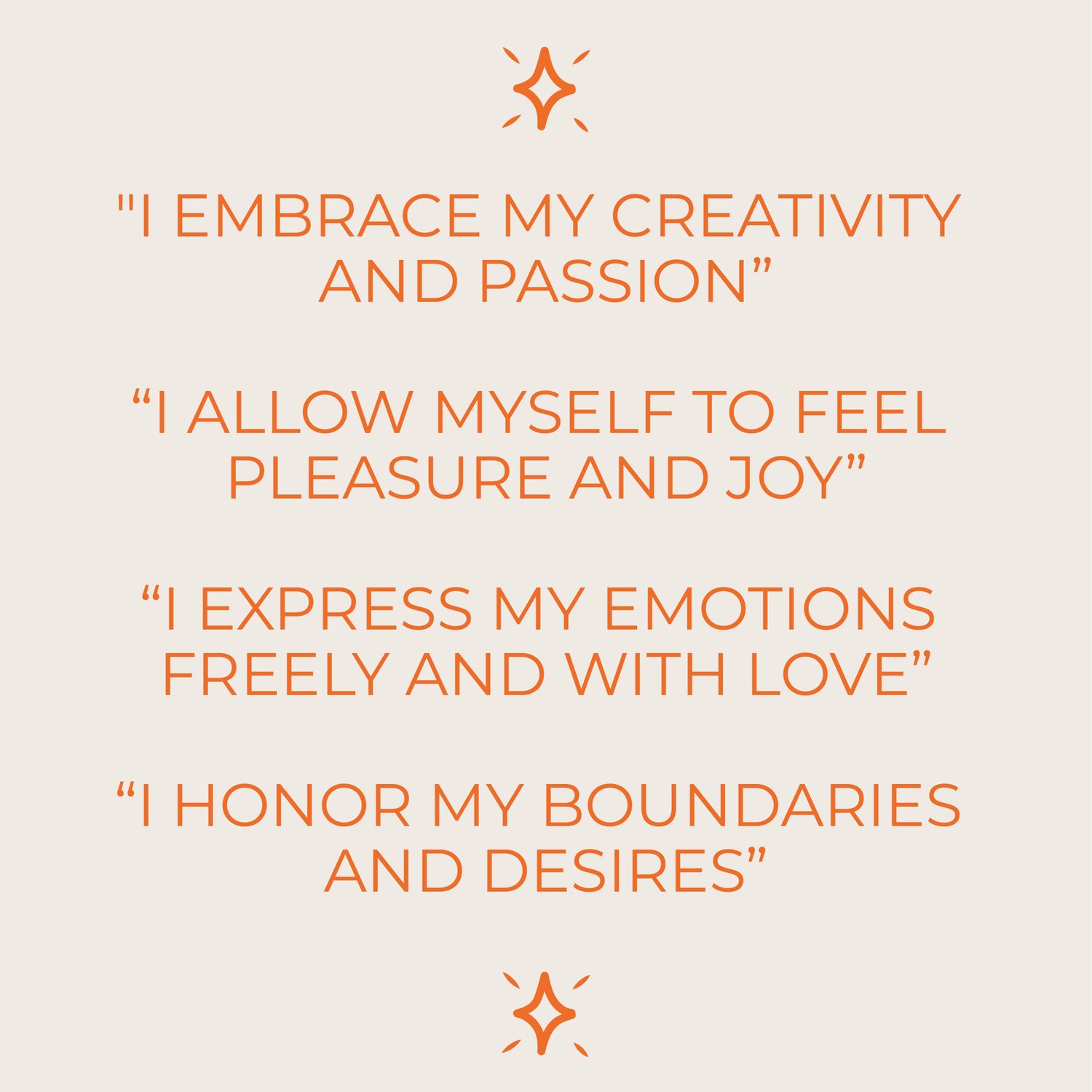SACRAL CHAKRA (Svadhisthana)

Sacral Chakra – The Center of Emotion, Pleasure, and Creativity
The Sacral Chakra, or Svadhisthana, comes from the Sanskrit words sva (self) and adhisthana (dwelling), meaning “one’s own abode.” It is the second energy center in the chakra system, representing the seat of emotions, creativity, sensuality, and joy.
Located just below the navel, Svadhisthana governs your capacity to feel deeply, express freely, and enjoy life’s pleasures. It’s the wellspring of desire, passion, and emotional intelligence — the energy that fuels relationships, artistic creation, and inner fulfillment.
When balanced, the Sacral Chakra allows you to embrace pleasure, move with fluidity, and connect authentically with others. When blocked, it may lead to emotional instability, creative blockages, or a sense of disconnection from joy.
Working with the Sacral Chakra invites you to reclaim your inner spark — honoring your emotions, your body, and the pure joy of being alive.


Where Is the Sacral Chakra Located?
The Sacral Chakra is located in the lower abdomen, just below the navel and above the pubic bone, near the sacrum (around the L5 vertebra). It sits between the Root and Solar Plexus chakras.
Energetically, it draws nurturing energy upward from the Root Chakra and transforms it into creative and emotional expression. This energy is then passed on to the Solar Plexus, fueling personal power and identity.
During meditation, many feel this chakra as a deep, expansive space — a gentle immersion into emotional safety, intimacy, and inner peace. It is the center where sensual joy and vulnerability are honored.

Symbolism of the Sacral Chakra
The symbol of the Sacral Chakra is a graceful lotus infused with symbols of movement, fluidity, and emotional depth.

Color: Orange
Radiates warmth, vitality, and creativity — the energy of joy, expression, and passion.
Circle (Cycle of Life)
Represents the continuous cycle of birth, death, and rebirth — a reminder of emotional flow and renewal.
Crescent Moon
Symbol of feminine energy, water, and the subconscious. It reflects intuitive wisdom and the natural rhythm of emotions.
Six Petals
Each petal symbolizes an emotion to be acknowledged and transformed: anger, jealousy, cruelty, hatred, pride, and desire — paving the way for emotional balance and creative liberation.
Together, these elements form the sacred geometry of Svadhisthana, the chakra that reminds us:
You are fluid. You are creative. You are alive.
Animal Symbols of the Sacral Chakra
The Sacral Chakra is linked to three animal archetypes, each symbolizing a vital aspect of emotional and creative energy:

Crocodile
Represents primal power, transformation, and the subconscious. This ancient water creature mirrors emotional depth, adaptability, and raw creative force.
Fish
Symbol of fertility, freedom, and abundance. Swimming with ease through water, the fish embodies Svadhisthana’s natural emotional flow and the joy of authentic self-expression.
Dolphin
A guide of playfulness, emotional intelligence, and social connection. The dolphin brings harmony, intuition, and joy to the emotional waters of this chakra.
Together, these sacred animals embody the essence of the Sacral Chakra — a place of pleasure, passion, and emotional freedom. They encourage you to dive in, feel deeply, and create with love.

Blocked Sacral Chakra – Signs, Effects & How to Heal

When the Sacral Chakra is blocked, you may feel emotionally numb, creatively stuck, or disconnected from pleasure. This energy center governs your emotions, sensuality, and self-expression — so an imbalance can affect your joy, motivation, and relationships.
These practices help unlock emotional flow and rekindle your inner spark.

Sacral Chakra Crystals – Energizing Gems for Creativity and Flow
Crystals attuned to the Sacral Chakra can help clear emotional blocks, boost creativity, and restore a sense of joy and flow.

How to Use Them:
- Meditate with a stone on your lower abdomen
- Wear crystal jewelry or carry a small stone in your pocket
- Place one on your altar or near your bed with a clear intention
These vibrant stones help you reconnect with your sensuality and self-worth — and invite creative energy to flow freely again.

Sacral Chakra Meditation – Awakening Creative Flow and Emotional Harmony
A Simple Sacral Chakra Meditation:
Find a comfortable seat or lie down. Bring your attention to the area just below your navel.
Visualize a warm orange glow expanding from this center. With each inhale, feel this light grow brighter — filling your body with creativity, emotional ease, and sensual energy.
With each exhale, release guilt, shame, or emotional tension.
Incorporate affirmations like:
“I honor my emotions.”
“I embrace pleasure and creativity.”
Let this practice reconnect you to your inner rhythm — nurturing emotional balance, joy, and your capacity to feel deeply. With regular meditation, you invite more fluidity, passion, and openness into your life.
Sacral Chakra Affirmations – Flow, Expression, and Connection
Sacral Chakra affirmations are healing phrases that help unlock your creativity, emotional depth, and joy for life.
Repeat them during meditation, while journaling, or as part of your daily routine.
Try affirmations like:

These affirmations help dissolve blocks caused by guilt or fear of vulnerability. Over time, they realign your energy with self-love, emotional honesty, and healthy connection — supporting a vibrant, balanced sacral chakra.

